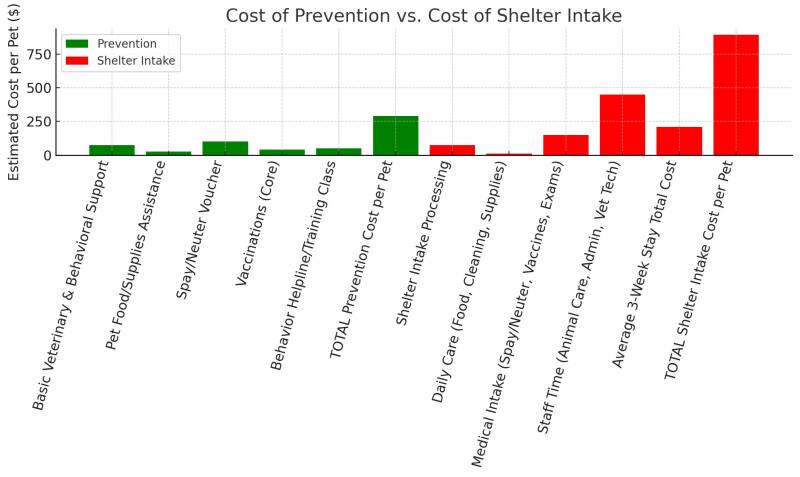Pet Support Services Information
Investing in community pet support services costs a fraction of what taxpayers spend on shelter intake, housing, and medical care for surrendered animals. By preventing pets from entering the shelter system in the first place, municipalities can save money, reduce overcrowding, and keep families together.
STOP!!! Take a moment and think about this.

Stronger Communities, Fewer Surrenders: Why NJ Needs Community Pet Support Services
Across New Jersey, animal shelters are at a tipping point. The companion animal overpopulation crisis has become so severe that many shelters are euthanizing adoptable pets—not because they are unwanted, but because there is simply no space or staff to care for them humanely.
The solution lies in prevention—stopping pets from entering the shelter system in the first place. That’s where Community Pet Support Services come in.
The Core Challenges Facing Pet Owners
Research and real-world data show that most pet surrenders stem from three preventable issues:
-
A lack of pet-friendly housing
-
A lack of affordable or accessible veterinary care
-
Behavior challenges in young, adolescent, and primarily large dogs
All of these challenges are solvable. Most are preventable. Communities can—and should—resolve to address them through upstream interventions that tackle the root causes before they turn into an emergency or crisis.
In cities where 95% of residents consider their pets family members, the lack of pet-friendly housing is devastating. Without intervention, families are forced to choose between a roof over their head and keeping their beloved companions.
Why Prevention Costs Less Than Intake
When municipalities fail to prevent pet surrenders, they end up paying far more to care for animals once they enter the shelter system. Every intake can mean:
-
Staffing Costs: More animals require more staff—animal control officers, kennel attendants, veterinary staff—resulting in higher salary and benefit expenses.
-
Longer Length of Stay: Animals awaiting adoption can stay weeks or months, occupying kennel space and tying up resources.
-
Supplies: Food, bedding, cleaning products, enrichment items—all add up daily.
-
Medical Care: Every intake must receive vaccines, parasite prevention, and—if not already altered—spay/neuter surgery.
-
Behavioral Care: Shelter environments can worsen behavior challenges, requiring extra staff time, training, or specialized rehabilitation.
These costs can quickly surpass what it would take to invest in upstream prevention programs like low-cost veterinary clinics, behavior helplines, and housing support.
📊 Example: A spay/neuter voucher and basic vaccines for a pet might cost under $200. Caring for the same pet in the shelter for three weeks could easily cost taxpayers $750–$1,000 or more.
Community Solutions That Work
These are programs municipalities and shelters can implement today—many with proven success:
-
Monthly Basic Veterinary & Behavioral Care
Shelters can dedicate one day each month to providing basic veterinary services directly to residents.
If the shelter is contracted, the municipality can cover a set cost per resident who uses the service.
This brings care and behavioral support directly to communities, helping pets stay healthy and families stay united.
📊 In 2023, this type of intervention reduced shelter intake by 22% in some communities. -
Expanded Foster Program
Recruit more foster caregivers so that homeless animals can be cared for in loving homes instead of overcrowded kennels. Municipalities can promote fostering as a civic contribution—neighbors helping neighbors. -
Pet Support Services
Build a broader safety net, including food pantries, supply distribution, housing assistance, low-cost vet care, behavior helplines, and even text-based support to guide owners through challenges. -
Pet Resource Center
Open a central hub where pet owners—especially those with limited funds—can access education, training materials, food, discounts, and referrals. In today’s economy, this group is growing, and municipalities can address the inequity by making resources easily available.
The Financial and Moral Win
By investing in Community Pet Support Services, municipalities can:
-
Prevent relinquishment before it happens
-
Support residents through crises without separating them from their pets
-
Reduce shelter overcrowding and euthanasia rates
-
Save taxpayer dollars by lowering the cost burden of intake, housing, and care for shelter animals.
Simply put: It costs less to keep pets in their homes than to care for them after they enter the shelter system.
Moving Forward Together
A strong community is one where everyone—whether they walk on two legs or four—can thrive. Municipal efforts should focus on preventing pet relinquishment, supporting pet owners in need, and expanding their reach so that no one is forced to say goodbye to a beloved companion due to circumstances beyond their control.
Your Voice Matters:
Ask your local leaders and shelter directors:
-
What programs exist to keep pets in their homes?
-
Are veterinary and behavioral support accessible and affordable?
-
Is there a Pet Resource Center for residents in need?
-
How are foster and volunteer opportunities promoted to the community?
If the answers aren’t strong enough, it’s time to speak up. By demanding upstream solutions, we can save lives, strengthen families, and build a more compassionate—and fiscally responsible—New Jersey.
"Every dollar a municipality invests in keeping pets in their homes saves multiple dollars in shelter costs—reducing intake, cutting medical and staffing expenses, and building a stronger, more compassionate community."
Companion Animal Advocates, NJ

